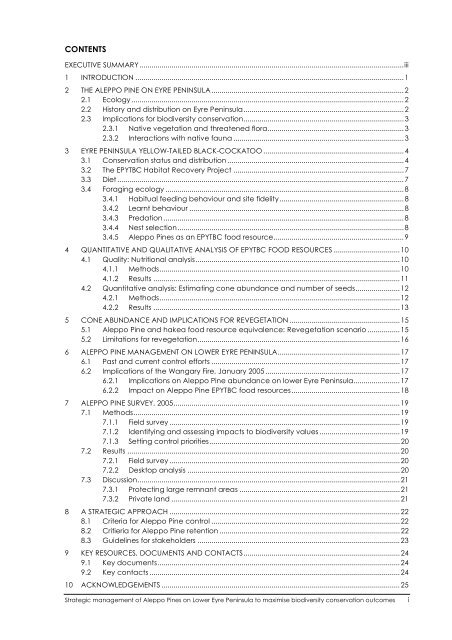Strategic management of Aleppo Pines on Lower Eyre
Strategic management of Aleppo Pines on Lower Eyre
Strategic management of Aleppo Pines on Lower Eyre
You also want an ePaper? Increase the reach of your titles
YUMPU automatically turns print PDFs into web optimized ePapers that Google loves.
CONTENTS<br />
EXECUTIVE SUMMARY ....................................................................................................................................iii<br />
1 INTRODUCTION ...................................................................................................................................... 1<br />
2 THE ALEPPO PINE ON EYRE PENINSULA ................................................................................................ 2<br />
2.1 Ecology ........................................................................................................................................ 2<br />
2.2 History and distributi<strong>on</strong> <strong>on</strong> <strong>Eyre</strong> Peninsula................................................................................ 2<br />
2.3 Implicati<strong>on</strong>s for biodiversity c<strong>on</strong>servati<strong>on</strong>................................................................................ 3<br />
2.3.1 Native vegetati<strong>on</strong> and threatened flora.................................................................... 3<br />
2.3.2 Interacti<strong>on</strong>s with native fauna ..................................................................................... 3<br />
3 EYRE PENINSULA YELLOW-TAILED BLACK-COCKATOO ...................................................................... 4<br />
3.1 C<strong>on</strong>servati<strong>on</strong> status and distributi<strong>on</strong> ........................................................................................4<br />
3.2 The EPYTBC Habitat Recovery Project ..................................................................................... 7<br />
3.3 Diet ............................................................................................................................................... 7<br />
3.4 Foraging ecology ....................................................................................................................... 8<br />
3.4.1 Habitual feeding behaviour and site fidelity.............................................................. 8<br />
3.4.2 Learnt behaviour ........................................................................................................... 8<br />
3.4.3 Predati<strong>on</strong> ........................................................................................................................ 8<br />
3.4.4 Nest selecti<strong>on</strong>.................................................................................................................8<br />
3.4.5 <str<strong>on</strong>g>Aleppo</str<strong>on</strong>g> <str<strong>on</strong>g>Pines</str<strong>on</strong>g> as an EPYTBC food resource................................................................. 9<br />
4 QUANTITATIVE AND QUALITATIVE ANALYSIS OF EPYTBC FOOD RESOURCES ................................. 10<br />
4.1 Quality: Nutriti<strong>on</strong>al analysis...................................................................................................... 10<br />
4.1.1 Methods........................................................................................................................10<br />
4.1.2 Results ........................................................................................................................... 11<br />
4.2 Quantitative analysis: Estimating c<strong>on</strong>e abundance and number <str<strong>on</strong>g>of</str<strong>on</strong>g> seeds...................... 12<br />
4.2.1 Methods........................................................................................................................12<br />
4.2.2 Results ........................................................................................................................... 13<br />
5 CONE ABUNDANCE AND IMPLICATIONS FOR REVEGETATION ....................................................... 15<br />
5.1 <str<strong>on</strong>g>Aleppo</str<strong>on</strong>g> Pine and hakea food resource equivalence: Revegetati<strong>on</strong> scenario ................ 15<br />
5.2 Limitati<strong>on</strong>s for revegetati<strong>on</strong>..................................................................................................... 16<br />
6 ALEPPO PINE MANAGEMENT ON LOWER EYRE PENINSULA............................................................. 17<br />
6.1 Past and current c<strong>on</strong>trol efforts .............................................................................................. 17<br />
6.2 Implicati<strong>on</strong>s <str<strong>on</strong>g>of</str<strong>on</strong>g> the Wangary Fire, January 2005 ................................................................... 17<br />
6.2.1 Implicati<strong>on</strong>s <strong>on</strong> <str<strong>on</strong>g>Aleppo</str<strong>on</strong>g> Pine abundance <strong>on</strong> lower <strong>Eyre</strong> Peninsula....................... 17<br />
6.2.2 Impact <strong>on</strong> <str<strong>on</strong>g>Aleppo</str<strong>on</strong>g> Pine EPYTBC food resources ...................................................... 18<br />
7 ALEPPO PINE SURVEY, 2005................................................................................................................. 19<br />
7.1 Methods..................................................................................................................................... 19<br />
7.1.1 Field survey ...................................................................................................................19<br />
7.1.2 Identifying and assessing impacts to biodiversity values ........................................ 19<br />
7.1.3 Setting c<strong>on</strong>trol priorities............................................................................................... 20<br />
7.2 Results ........................................................................................................................................ 20<br />
7.2.1 Field survey ...................................................................................................................20<br />
7.2.2 Desktop analysis ..........................................................................................................20<br />
7.3 Discussi<strong>on</strong>................................................................................................................................... 21<br />
7.3.1 Protecting large remnant areas ................................................................................ 21<br />
7.3.2 Private land .................................................................................................................. 21<br />
8 A STRATEGIC APPROACH ................................................................................................................... 22<br />
8.1 Criteria for <str<strong>on</strong>g>Aleppo</str<strong>on</strong>g> Pine c<strong>on</strong>trol .............................................................................................. 22<br />
8.2 Critieria for <str<strong>on</strong>g>Aleppo</str<strong>on</strong>g> Pine retenti<strong>on</strong> .......................................................................................... 22<br />
8.3 Guidelines for stakeholders ..................................................................................................... 23<br />
9 KEY RESOURCES, DOCUMENTS AND CONTACTS.............................................................................. 24<br />
9.1 Key documents......................................................................................................................... 24<br />
9.2 Key c<strong>on</strong>tacts ............................................................................................................................. 24<br />
10 ACKNOWLEDGEMENTS ....................................................................................................................... 25<br />
<str<strong>on</strong>g>Strategic</str<strong>on</strong>g> <str<strong>on</strong>g>management</str<strong>on</strong>g> <str<strong>on</strong>g>of</str<strong>on</strong>g> <str<strong>on</strong>g>Aleppo</str<strong>on</strong>g> <str<strong>on</strong>g>Pines</str<strong>on</strong>g> <strong>on</strong> <strong>Lower</strong> <strong>Eyre</strong> Peninsula to maximise biodiversity c<strong>on</strong>servati<strong>on</strong> outcomes i

















